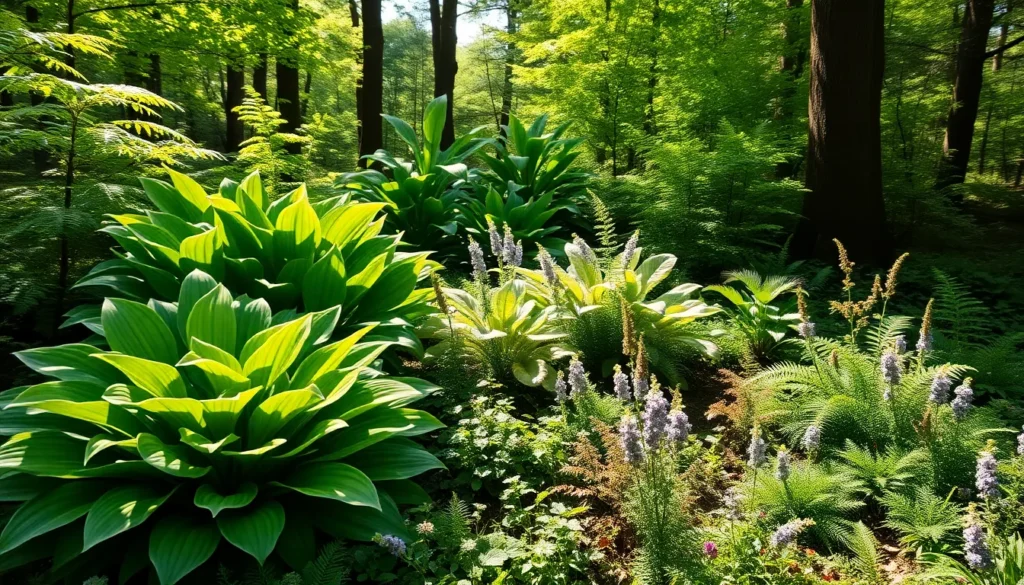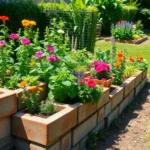We’ve all admired those stunning shade gardens that seem to glow with lush green foliage and elegant textures. Hostas are the secret behind these captivating outdoor spaces, transforming ordinary shaded areas into breathtaking garden sanctuaries. These versatile perennials offer endless possibilities for creating dramatic focal points, serene walkways, and layered landscapes that thrive where other plants struggle.
Whether you’re dealing with deep shade under mature trees or looking to add sophistication to your garden borders, hostas deliver unmatched beauty with minimal maintenance. From compact varieties perfect for containers to giant specimens that create living sculptures, these remarkable plants adapt to nearly any garden vision you have in mind.
We’re about to explore creative hosta garden ideas that’ll help you design outdoor spaces bursting with color, texture, and year-round appeal. Get ready to discover how these shade-loving champions can transform your challenging garden spots into your favorite outdoor retreats.
Create a Stunning Shade Garden Foundation With Mixed Hosta Varieties
Building upon the groundbreaking power of hostas, we’ll explore how combining different varieties creates depth and visual interest in your shade garden. Mixing hostas strategically establishes a foundation that delivers year-round beauty with minimal upkeep.
Choose Complementary Leaf Colors and Textures
Color combinations anchor successful hosta garden designs by creating focal points and visual flow throughout your space. We recommend pairing blue-leafed varieties like ‘Halcyon’ with golden options such as ‘Sum and Substance’ to establish striking contrast. Variegated hostas including ‘Patriot’ and ‘Fire and Ice’ bridge color gaps while adding movement to your garden composition.
Texture variation prevents monotony and adds tactile appeal to your hosta display. Smooth-leafed varieties like ‘Blue Angel’ contrast beautifully with heavily textured options such as ‘Abiqua Drinking Gourd’. Combining narrow, lance-shaped leaves from ‘Lancifolia’ with broad, heart-shaped foliage from ‘Sum and Substance’ creates ever-changing visual layers.
Size diversity amplifies texture impact by showcasing different leaf proportions. Miniature hostas with delicate leaves complement giant specimens featuring dinner-plate-sized foliage. We suggest grouping three to five plants of each texture type to create cohesive patches rather than scattered individual specimens.
Plan for Different Mature Sizes and Growth Habits
Strategic placement based on mature dimensions ensures each hosta variety reaches its full potential without overcrowding neighbors. Giant hostas like ‘Empress Wu’ require 4-6 feet of spacing and serve as natural backdrops for smaller varieties. Medium-sized options such as ‘June’ work perfectly in middle positions, bridging the gap between large and small specimens.
Miniature hostas including ‘Mouse Ears’ and ‘Teaspoon’ excel as edging plants or container specimens where their intricate details can be appreciated up close. These compact varieties mature at 6-12 inches and complement larger hostas without competing for attention. We position them along pathways or in raised beds for optimal viewing.
Growth habits influence long-term garden success and maintenance requirements. Clumping varieties stay contained and predictable, while spreading types like ‘Plantaginea’ gradually expand to fill designated areas. Fast-growing hostas establish quickly but may require division every 3-4 years, whereas slow-growing varieties maintain their form for decades with minimal intervention.
| Hosta Size Category | Mature Height | Mature Width | Spacing Requirements |
|---|---|---|---|
| Miniature | 4-6 inches | 6-12 inches | 12-18 inches |
| Small | 6-10 inches | 12-18 inches | 18-24 inches |
| Medium | 10-18 inches | 18-36 inches | 24-36 inches |
| Large | 18-28 inches | 36-48 inches | 36-48 inches |
| Giant | 28+ inches | 48+ inches | 48-72 inches |
Consider Bloom Times for Extended Interest
Staggered bloom periods extend your hosta garden’s appeal from early summer through fall, providing continuous flowers when many shade plants have finished blooming. Early bloomers like ‘Royal Standard’ produce fragrant white flowers in July, followed by mid-season varieties such as ‘Guacamole’ in August. Late-blooming hostas including ‘Autumn Frost’ carry the display into September and October.
Fragrant hosta flowers add sensory dimension to your shade garden experience. Plantain lilies (Hosta plantaginea) and their hybrids produce intensely fragrant evening blooms that attract nocturnal pollinators. We position these aromatic varieties near seating areas or pathways where their sweet scent can be enjoyed during evening garden visits.
Flower colors range from pure white to deep purple, offering coordination opportunities with your foliage palette. White flowered varieties like ‘Honeybells’ complement blue and green leafed hostas, while purple blooms from ‘Purple Lady Finger’ enhance golden and chartreuse foliage. Removing spent flower stalks redirects energy to leaf production, but leaving seed pods provides winter interest and natural reseeding opportunities.
Design Eye-Catching Hosta Borders Along Walkways and Patios
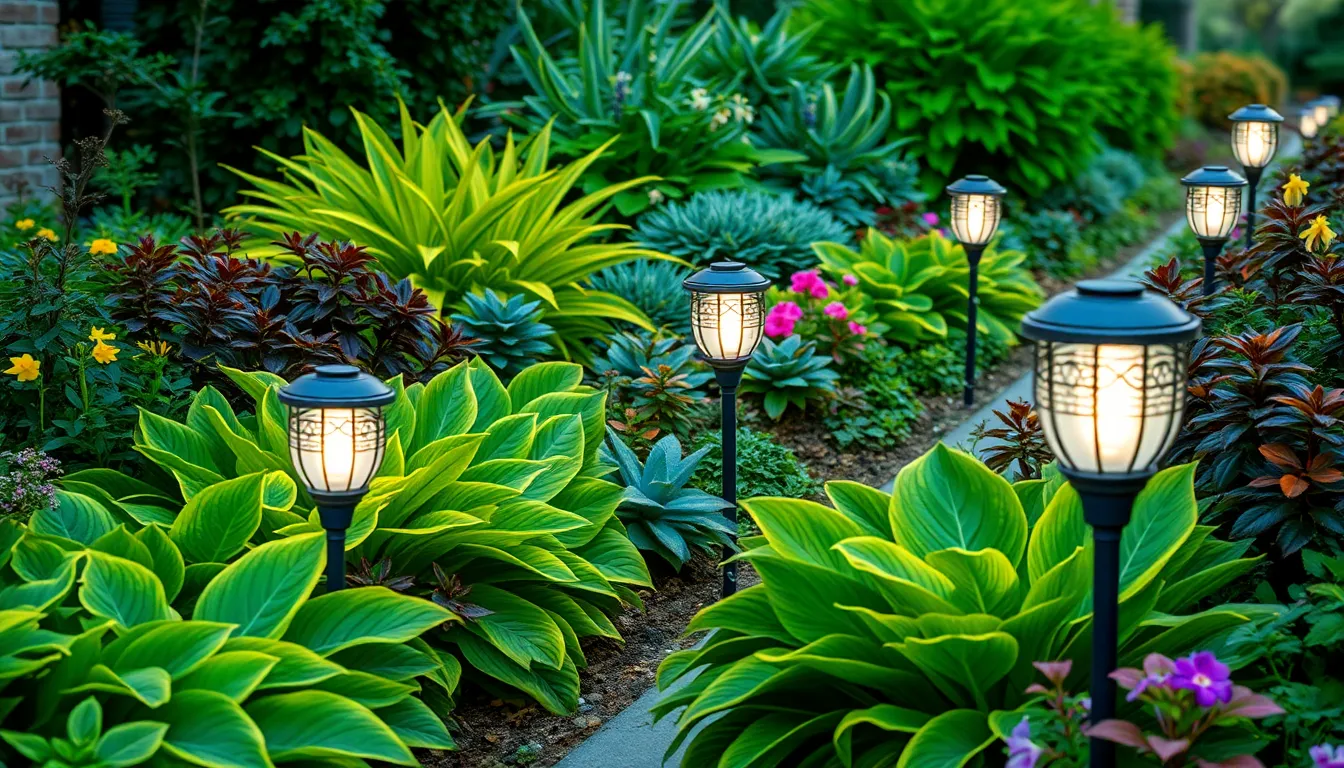
Creating stunning hosta borders transforms ordinary pathways into captivating garden features. We can enhance these spaces by implementing strategic design elements that maximize visual appeal throughout the growing season.
Use Graduated Heights for Visual Impact
Layer plantings strategically to create dimensional borders that draw the eye naturally through your industry. Position large hostas like ‘Sum and Substance’ at the back of borders, maintaining 30 to 36 inches between each specimen to accommodate their mature spread.
Place medium-sized varieties such as ‘Francee’ and ‘Christmas Tree’ in the middle tier, spacing them 18 to 24 inches apart for optimal growth and visual balance. These variegated hostas add vibrant patterns that create natural transition zones between larger and smaller specimens.
Position compact hostas at the front edge, allowing 12 to 18 inches between plants to prevent overcrowding while maintaining full coverage. Miniature varieties like ‘Blue Mouse Ears’ work perfectly for pathway edges where space is limited.
Use containers of varying heights to add instant vertical interest and create moveable focal points throughout your border design. We can group different sized planters to establish visual layers without permanent plant placement.
Incorporate Seasonal Color Changes
Choose seasonal hostas that transform throughout the growing season to maintain continuous visual interest in your border plantings. Many varieties shift from spring emergence colors to summer maturity tones, then develop autumn characteristics before dormancy.
Select varieties with staggered bloom times to extend flowering periods from early summer through late fall. Some hostas produce fragrant flowers in July, while others bloom later in August and September.
Add companion plants like hydrangeas and azaleas that complement hosta foliage while providing seasonal flower displays. These partnerships create ever-changing color combinations that evolve throughout the year.
Plant ferns alongside hostas to maintain textural interest during seasonal transitions. Their architectural fronds provide consistent green backdrops that highlight changing hosta colors.
Add Lighting to Highlight Evening Appeal
Install solar-powered lights strategically throughout your hosta borders to showcase the dramatic foliage textures after sunset. Position these fixtures to uplight large hosta specimens, creating stunning shadow patterns on nearby surfaces.
Hang string lights at varying heights above border plantings to establish ambient lighting that enhances the lush appearance of hosta leaves. We recommend warm white LED options that complement natural foliage colors without overwhelming plant features.
Place pathway lighting along walkway edges to provide safe navigation while illuminating the beautiful hosta displays below. Low-voltage fixtures prevent light pollution while maintaining visibility of your carefully designed plant arrangements.
Use accent lighting to highlight exact specimen hostas or companion plant combinations that serve as focal points within your border design. Adjustable fixtures allow us to modify lighting angles seasonally as plants grow and change.
Build Layered Woodland Gardens Using Hostas as Anchor Plants
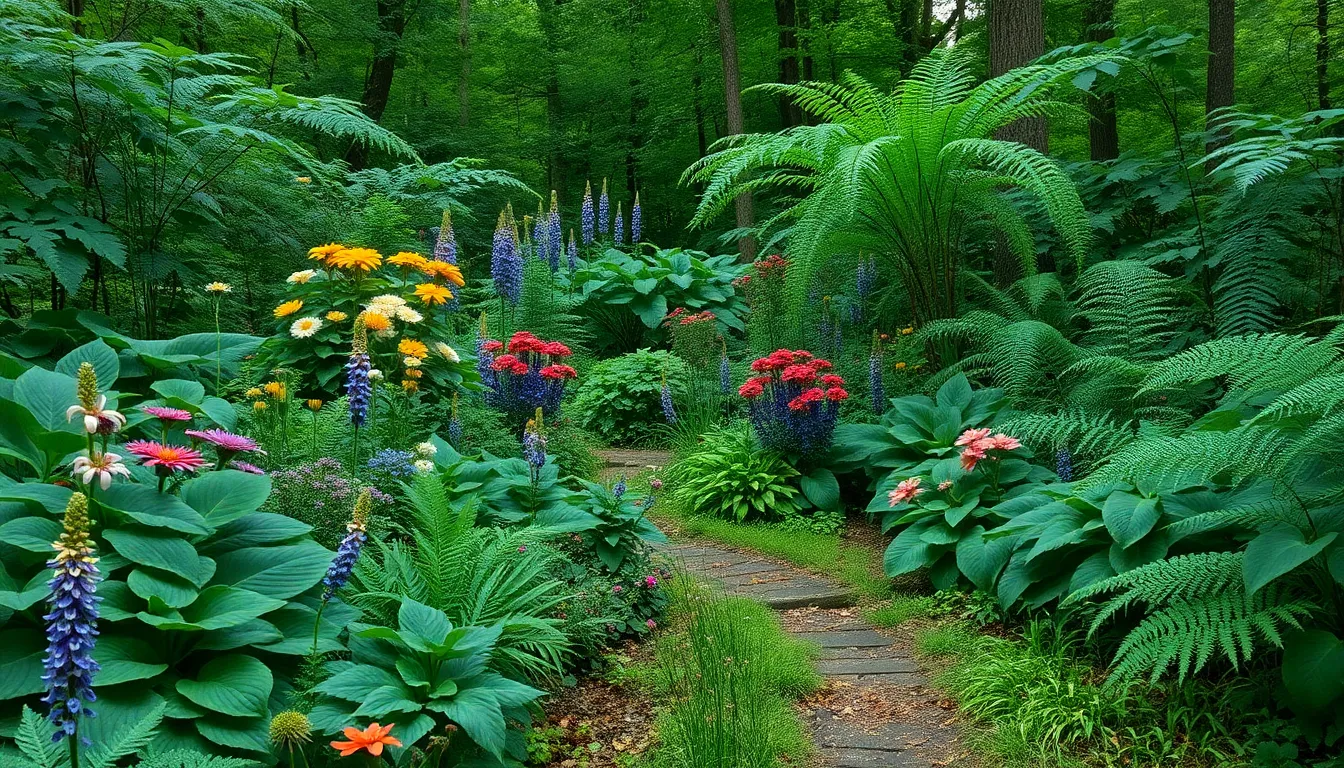
We love using large hostas as the foundation of our woodland gardens because they create excellent anchor points for designing layered shade spaces. These versatile perennials come in various foliage colors and serve as the perfect base layer for building depth and visual interest throughout your garden design.
Combine With Native Ferns and Wildflowers
Pairing hostas with native ferns creates one of nature’s most harmonious combinations in shade gardening. We recommend selecting ferns with contrasting foliage textures to add visual depth around your established hosta plantings. Woodland ferns like Christmas fern, lady fern, and maidenhair fern work exceptionally well because their delicate fronds complement the broad leaves of hostas.
Native wildflowers bring essential pops of color to your hosta and fern combinations while supporting local pollinators. Wild ginger, trillium, bloodroot, and jack-in-the-pulpit are excellent choices that naturalize beautifully among hosta clumps. These additions enhance both biodiversity and aesthetic appeal by creating a more authentic woodland atmosphere.
We’ve found that this three-layer approach using hostas, ferns, and wildflowers mimics natural forest floor ecosystems. Each plant fills a different ecological niche while contributing to the overall garden composition through varying heights, textures, and seasonal interest.
Create Natural-Looking Plant Groupings
Grouping 3 to 5 hostas of the same variety together produces the strongest visual impact in woodland settings. We always cluster identical varieties rather than spacing single plants throughout the garden because this creates more natural-looking drifts. Solid-colored hostas work particularly well for establishing these cohesive groupings that anchor your overall design.
Repeating exact hosta varieties or leaf colors throughout different areas helps guide the viewer’s eye and creates visual continuity. We strategically place these repeated elements at key points to establish rhythm and flow throughout the woodland garden. This technique prevents the space from looking scattered or randomly planted.
Varying the heights of your plant groupings adds essential depth to woodland compositions. Place taller hostas like ‘Sum and Substance’ at the back, medium varieties in the middle layer, and compact selections at the front edges. This layered approach creates natural transitions that feel authentic rather than forced.
Establish Proper Soil Conditions for Thriving Growth
Hostas require well-draining, consistently moist soil enriched with organic matter to reach their full potential in woodland gardens. We ensure our soil retains moisture without becoming waterlogged by incorporating compost, leaf mold, or aged bark into the planting area. Rich, organic soil supports the lush foliage growth that makes hostas such effective anchor plants.
Mulching around your hosta plantings serves multiple essential functions in woodland garden maintenance. We apply a 2-3 inch layer of organic mulch to retain soil moisture, suppress competing weeds, and gradually improve soil structure as it decomposes. Shredded leaves, bark chips, or aged compost work best for maintaining the natural woodland aesthetic.
Proper soil preparation extends beyond just the immediate planting area in successful woodland gardens. We recommend improving soil quality throughout the entire garden space because hostas’ extensive root systems will eventually spread beyond their original planting holes. This comprehensive approach ensures long-term success for your layered woodland design.
Establish Dramatic Container Gardens Featuring Hosta Collections
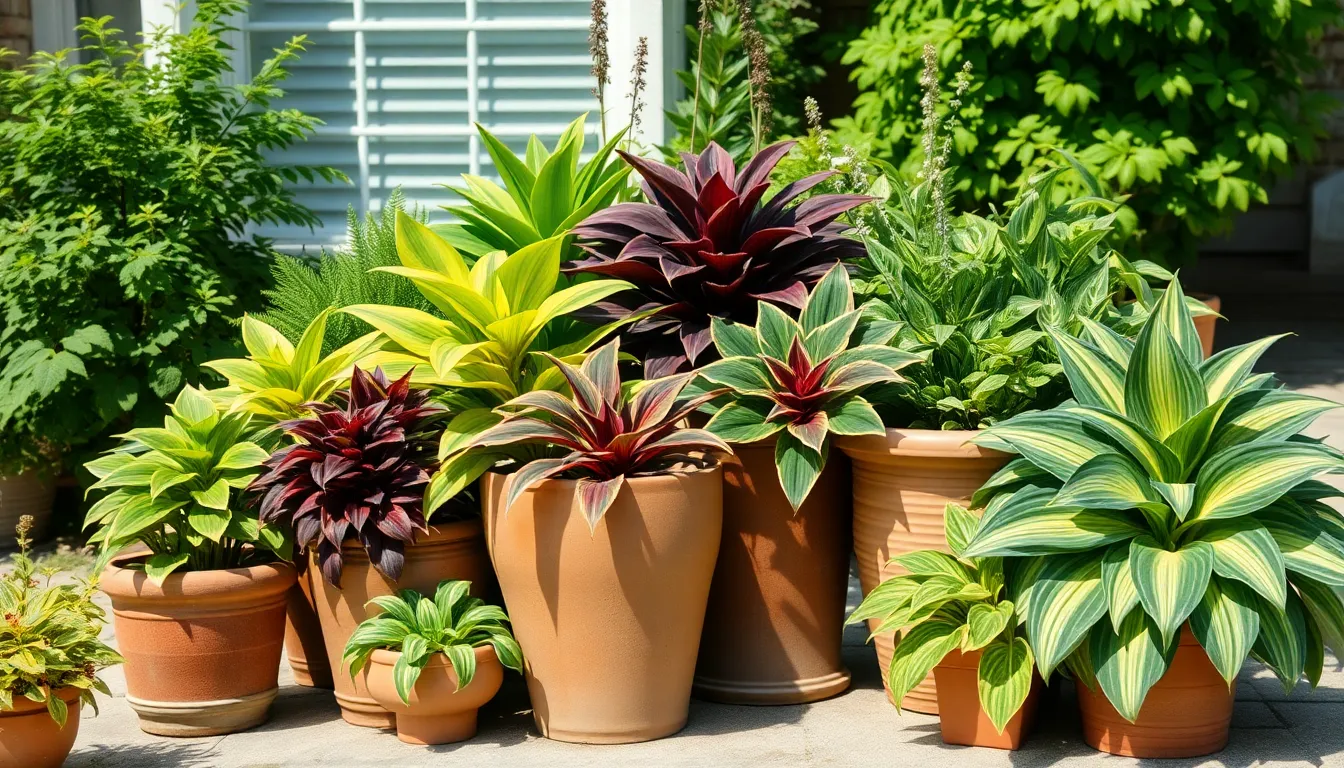
Container gardening offers exciting opportunities to showcase hosta collections in focused, dramatic displays. We can create stunning portable gardens that highlight the incredible diversity of these shade-loving perennials.
Select Appropriate Pot Sizes and Materials
Matching pot dimensions to mature hosta size ensures optimal growth and visual balance. Small varieties like ‘Blue Mouse Ears’ thrive in compact containers, while giants like ‘Sum and Substance’ demand spacious vessels to accommodate their impressive spread. We recommend measuring the expected mature width of your chosen hosta variety and selecting containers at least 2-3 inches wider on all sides.
Material selection directly impacts plant health and container longevity. Ceramic, terracotta, and quality plastic containers provide excellent drainage properties that prevent the root rot issues common in poorly draining pots. Weight considerations become crucial when planning container placement, especially for large hosta specimens that may require sturdy ceramic or composite materials. Style harmony between containers and garden settings creates cohesive visual appeal while supporting the plants’ mature size requirements.
Create Striking Color Combinations
Variegated hostas like ‘Patriot’ and ‘Fire and Ice’ serve as natural focal points through their dramatic leaf patterns. These varieties introduce immediate visual interest with their bold color variations that draw the eye and anchor container compositions. We find that positioning variegated specimens as centerpieces allows their unique markings to shine while providing structure for surrounding plants.
Cool-toned blue hostas paired with vibrant green varieties generate striking depth and contrast. Large blue specimens like ‘Empress Wu’ create bold textural impact when combined with chartreuse or golden green companions. This color pairing mimics natural woodland patterns while amplifying the dramatic effect we seek in container displays.
Neutral and contrasting foliage plants enhance hosta leaf textures and colors without competing for attention. We integrate shade-loving perennials and complementary green plants that support rather than overshadow the hostas’ distinctive characteristics. These supporting players enrich the overall design while maintaining focus on the hosta collection’s natural beauty.
Plan for Year-Round Container Care
Variety selection based on light tolerance ensures container success in diverse garden locations. Some hostas like ‘Sun and Substance’ handle brighter conditions better than traditional shade varieties, expanding placement options for container gardens. We match hosta varieties to exact light conditions and pot environments to maximize growth potential and minimize stress.
Proper drainage systems combined with quality potting soil create ideal growing conditions. Containers must feature adequate drainage holes while using soil mixes that retain moisture without becoming waterlogged. We layer drainage materials in container bottoms and select potting blends specifically formulated for container growing to support healthy root development.
Seasonal watering adjustments maintain plant health throughout the growing cycle. Regular watering during active growth periods supports lush foliage development, while reduced watering in dormant seasons prevents root problems. Winter protection through mulching or insulation shields container roots from freezing temperatures that can damage or kill plants.
Division and repotting every few years maintains plant vigor and prevents overcrowding. We monitor container hostas for signs of declining growth or overcrowded conditions that indicate the need for division. This maintenance practice ensures continued dramatic displays while providing opportunities to expand collections or refresh container compositions.
Transform Problem Areas With Low-Maintenance Hosta Solutions
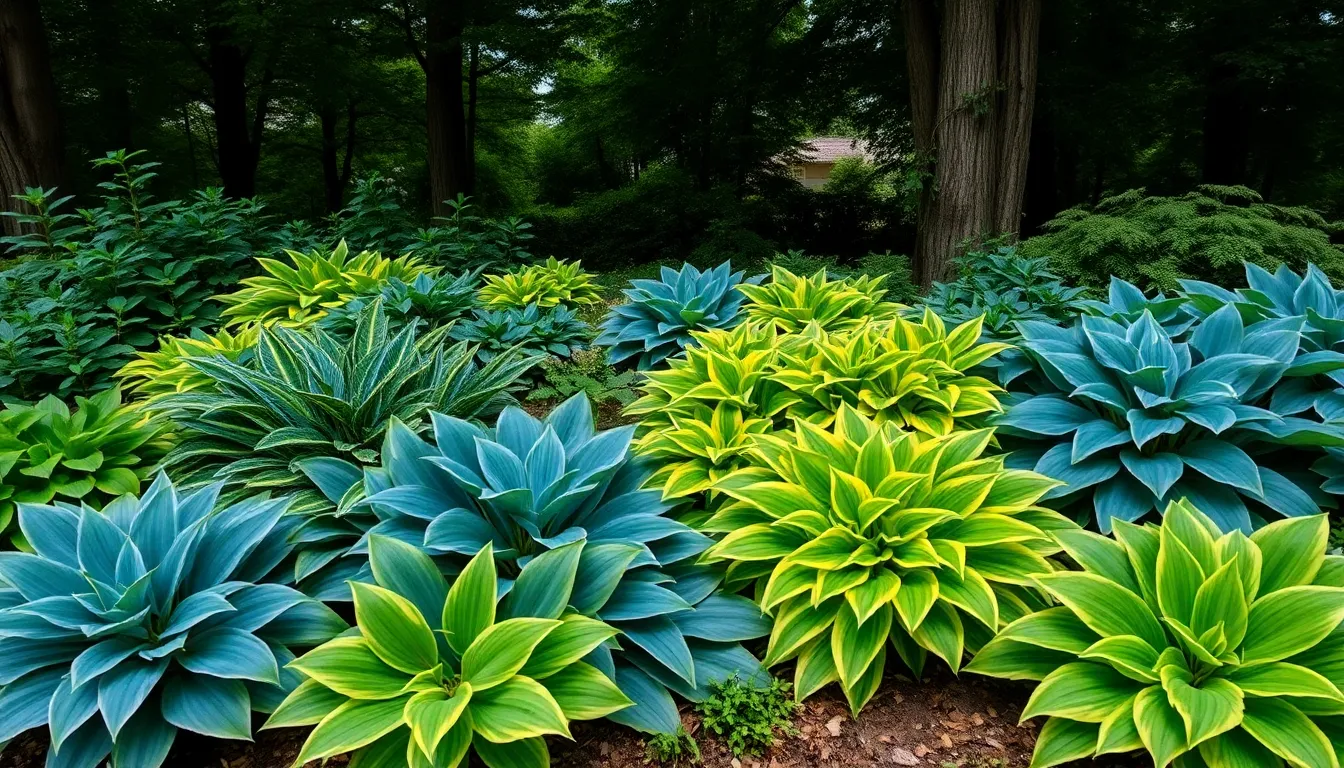
We can turn our garden’s most challenging areas into beautiful focal points using hostas’ natural adaptability. These versatile perennials excel where other plants struggle, making them perfect answers for common landscaping problems.
Convert Dense Shade Spots Into Garden Assets
Dense shade areas become stunning garden features when we plant hostas strategically throughout these challenging spaces. Thousands of hosta varieties offer different sizes, shapes, and colors that easily brighten up dark spots where other plants fail to thrive. We can select compact varieties like ‘Blue Mouse Ears’ for tight spaces or giant specimens such as ‘Sum and Substance’ to create dramatic statements in larger shaded areas.
Layering different hosta textures creates visual depth in previously unusable spaces. Blue-green varieties like ‘Halcyon’ pair beautifully with chartreuse selections such as ‘August Moon’ to establish striking color contrasts. We achieve the most impact by grouping hostas in clusters of three to five plants rather than spacing them individually throughout the area.
Control Erosion on Sloped Areas
Sloped gardens benefit tremendously from hostas’ robust root systems that naturally stabilize soil and prevent erosion. We plant hostas on slopes to create lush landscapes while addressing practical concerns about soil loss during heavy rains. Their spreading root networks anchor soil effectively, making them ideal for hillside plantings that require both beauty and function.
Staggered planting patterns work best for erosion control on slopes. We space larger varieties like ‘Patriot’ or ‘Frances Williams’ every 3-4 feet along the slope’s natural contours. Smaller hostas fill gaps between these anchor plants, creating a continuous root matrix that holds soil in place. This approach transforms problematic slopes into attractive terraced gardens that require minimal maintenance once established.
Fill Gaps Under Trees and Large Shrubs
Challenging spaces under established trees and shrubs become productive garden areas when we use hostas’ shade tolerance. These hard-to-industry spots often remain bare because limited sunlight prevents most plants from thriving. We select hostas specifically bred for deep shade conditions to fill these gaps effectively.
Ground-hugging varieties like ‘Ginko Craig’ spread naturally to cover bare soil under shrubs. Taller selections such as ‘Royal Standard’ work well beneath high-branched trees where we need more substantial plant presence. We combine different hosta heights and textures to create interesting compositions that complement existing industry features rather than competing with them.
Incorporate Water Features Surrounded by Lush Hosta Displays
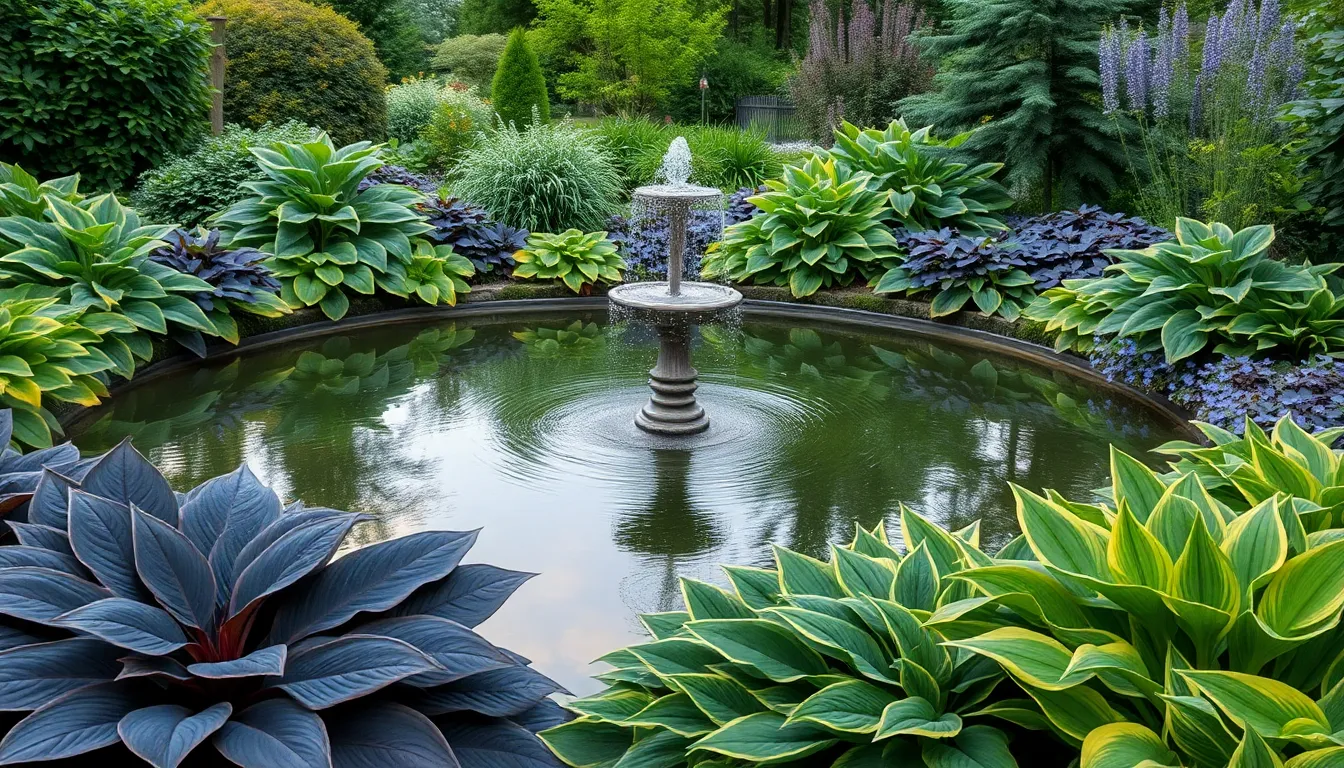
Water features paired with hostas create stunning focal points that enhance your garden’s tranquility while maximizing the potential of shaded areas. These combinations work beautifully because hostas thrive in the moisture rich environments that naturally occur around ponds, streams, and fountains.
Design Pond Edges With Moisture-Loving Varieties
Pond edges benefit tremendously from strategic hosta placement, as these areas provide the perfect growing conditions with consistent moisture and natural shade. We recommend selecting large leaf varieties like ‘Sum and Substance’ or ‘Empress Wu’ to create dramatic backdrops that soften hard pond edges while establishing visual weight around water features.
Position hostas 18 to 24 inches back from pond edges to prevent root systems from interfering with pond liners while still capturing reflected moisture. Blue hostas such as ‘Halcyon’ and ‘Blue Angel’ work exceptionally well near water because their cool tones complement reflective surfaces and create calming color palettes.
Layer different sized varieties to establish depth and natural flow around pond perimeters. Place giant hostas as anchor plants, medium varieties for transition zones, and compact types like ‘Mouse Ears’ for detailed edging that won’t overwhelm smaller water features.
Create Stream Banks With Cascading Foliage
Stream banks transform into living artwork when we design them with cascading hosta foliage that frames moving water naturally. Hostas with arching growth habits like ‘Sagae’ and ‘Liberty’ work perfectly for this application because their leaves gracefully bend toward water sources.
Plant hostas in staggered groupings along stream banks to create organic looking borders that mimic natural waterside vegetation. This technique prevents formal appearances while ensuring adequate coverage for erosion control in moisture rich soil conditions.
Choose variegated varieties to add brightness along stream edges where dappled sunlight filters through overhead canopy. Golden edged hostas like ‘Patriot’ and ‘Fire and Ice’ provide striking contrast against dark water while maintaining the lush appearance that complements flowing streams.
Combine different textures by mixing smooth leaf hostas with corrugated varieties to create visual interest that changes as viewers move along stream paths. This approach ensures ever-changing displays that engage multiple viewing angles.
Add Fountains as Focal Points Among Hosta Beds
Fountains serve as dramatic centerpieces when surrounded by carefully planned hosta arrangements that create peaceful atmospheres perfect for shade garden environments. We position fountains to maximize sound distribution while ensuring adequate space for mature hosta growth around these focal points.
Create circular planting beds around fountains using progressively larger hosta varieties as distance from the fountain increases. This design approach establishes proper scale relationships while ensuring smaller varieties near fountains won’t be overwhelmed by water splash.
Select fragrant flowering hostas like ‘Royal Standard’ and ‘Guacamole’ to enhance sensory experiences around fountain areas where people naturally pause to enjoy water sounds. These varieties bloom in late summer, extending seasonal interest when combined with fountain features.
Install proper drainage systems beneath hosta beds surrounding fountains to prevent waterlogged conditions that could damage root systems. Well draining soil mixed with organic matter ensures hostas thrive in consistently moist but not saturated conditions that fountain proximity creates.
Develop Themed Hosta Gardens Based on Specific Design Concepts
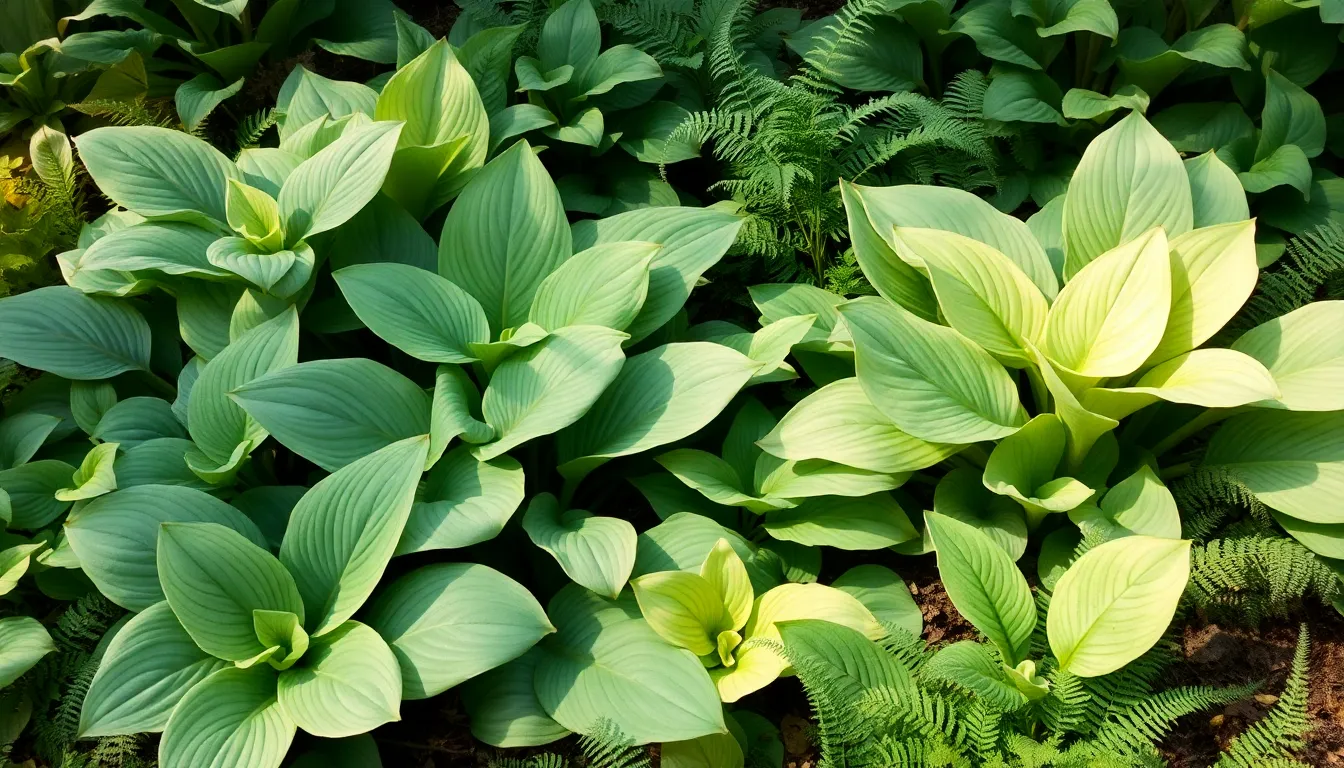
Themed hosta gardens elevate ordinary shade spaces into extraordinary outdoor experiences that reflect exact design concepts and personal interests. We can transform our shaded areas by selecting hostas that align with particular themes, creating cohesive landscapes that tell compelling stories through foliage and form.
Create Monochromatic Color Schemes
Monochromatic hosta gardens achieve stunning visual harmony by focusing on varying shades of a single color family. We recommend grouping different green-shaded hostas like ‘Sum and Substance’, ‘Empress Wu’, and ‘Blue Angel’ to create a soothing, cohesive industry that emphasizes foliage texture over color contrast.
Blue-toned monochromatic schemes work exceptionally well with varieties such as ‘Hadspen Blue’, ‘Blue Cadet’, and ‘Blue Mouse Ears’. These selections create depth through size variation while maintaining color consistency that feels both sophisticated and calming.
Yellow and chartreuse monochromatic gardens bring brightness to shaded areas using cultivars like ‘Sum and Substance’, ‘August Moon’, and ‘Gold Standard’. This approach maintains visual harmony while adding luminosity to darker garden spaces that might otherwise feel too shadowy.
White and cream variegated hostas create elegant monochromatic displays when we combine varieties like ‘Patriot’, ‘Francee’, and ‘Albomarginata’. These selections provide subtle color variation within the white family while creating sophisticated, light-reflecting garden spaces.
Design Texture-Focused Gardens
Texture-focused hosta gardens celebrate the incredible diversity of leaf surfaces and forms these perennials offer. We can combine smooth-leafed varieties like ‘Royal Standard’ with deeply puckered cultivars such as ‘Shadowland Autumn Frost’ to create compelling tactile contrasts that invite closer inspection.
Glossy-leafed hostas like ‘Guacamole’ paired with matte-finished varieties such as ‘Blue Angel’ generate visual interest through light reflection differences. This combination creates ever-changing displays that change throughout the day as lighting conditions shift across our garden spaces.
Combining hostas with complementary woodland plants amplifies textural diversity significantly. Ferns provide feathery contrast to broad hosta leaves, while heuchera adds ruffled textures that bridge the gap between delicate fern fronds and substantial hosta foliage.
Corrugated and heavily textured hostas like ‘Abiqua Drinking Gourd’ create focal points within texture gardens. We position these dramatic specimens strategically to draw attention while surrounding them with smoother-leafed varieties that don’t compete for visual dominance.
Establish Fragrant Hosta Collections
Fragrant hosta collections focus on varieties that produce sweetly scented flowers during their blooming periods. We select cultivars like ‘Fragrant Bouquet’, ‘Fragrant Blue’, and ‘Summer Fragrance’ to create gardens that appeal to multiple senses throughout the growing season.
Evening-blooming fragrant hostas such as ‘Royal Standard’ and ‘Honeybells’ release their strongest scents after sunset. These varieties work perfectly for areas where we spend time during cooler evening hours, creating memorable sensory experiences in our outdoor spaces.
Combining fragrant hostas with complementary aromatic companion plants enhances the overall sensory garden experience. We integrate plants like sweet woodruff, wild ginger, and fragrant ferns to create layered scent profiles that change throughout the growing season.
Positioning fragrant hosta collections near seating areas, pathways, or windows maximizes our enjoyment of their seasonal blooms. Strategic placement ensures we experience these subtle fragrances during regular garden activities while maintaining the visual appeal of foliage-focused design concepts.
Combine Hostas With Complementary Perennials for Dynamic Plantings
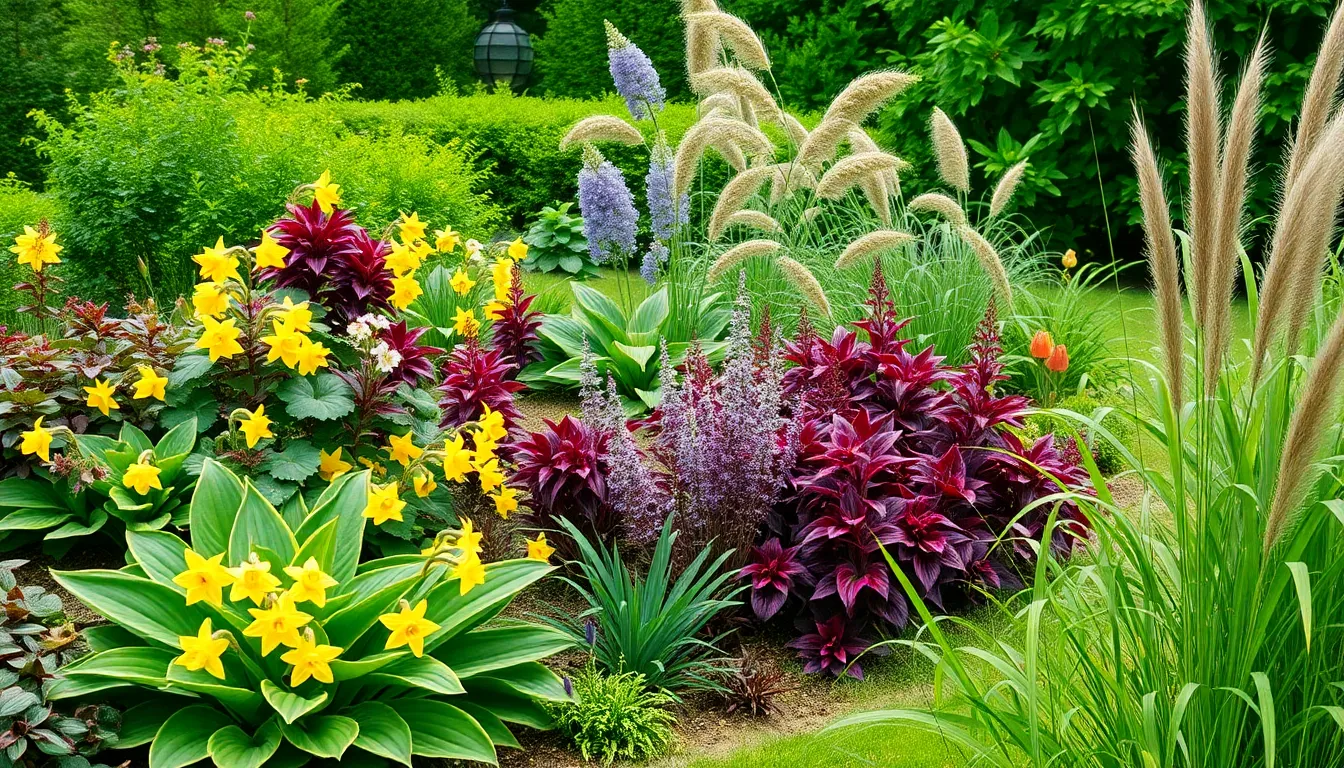
Mixing hostas with carefully selected perennials creates layered gardens that maintain visual interest throughout multiple seasons. Strategic plant partnerships transform static shade areas into ever-changing landscapes that evolve and change as different elements reach their peak performance periods.
Pair With Spring Bulbs for Early Season Color
Spring bulbs planted among hostas provide brilliant early color before hosta foliage fully emerges. Daffodils, tulips, and crocuses bloom when hostas are just beginning to sprout, creating perfect seasonal succession without competing for space. We recommend planting bulbs in clusters between hosta crowns to maximize impact while allowing both plants to flourish.
Early season brightness transforms shady areas that would otherwise remain dormant during cool spring months. Bulb flowers fade naturally as hosta leaves expand to fill the space, creating seamless transitions from spring blooms to summer foliage displays. This pairing strategy doubles the productive use of garden real estate without overcrowding.
Add Astilbe and Heuchera for Contrasting Textures
Astilbe’s feathery flower plumes create striking textural contrast against smooth or puckered hosta leaves. These perennials complement each other perfectly because astilbe’s soft, airy blooms rise above the broad horizontal lines of hosta foliage. We’ve found that combining different astilbe colors with various hosta leaf patterns produces visually captivating compositions.
Heuchera contributes vibrant foliage colors ranging from deep purple to bright green that pop against hosta’s predominantly green palette. Ruffled heuchera leaves add another textural dimension while their compact growth habit fits perfectly in front of larger hostas. Both companions thrive in similar shade conditions, making maintenance straightforward while extending visual interest beyond foliage alone.
Include Ornamental Grasses for Movement and Structure
Ornamental grasses introduce vertical lines and gentle swaying motion that balance hostas’ broad, static forms. Fine textured grass blades create ever-changing movement even in light breezes, adding liveliness to otherwise still shade garden compositions. Positioning grasses strategically behind or beside hosta groupings enhances depth perception and creates more sophisticated layering.
Movement from ornamental grasses prevents shade gardens from appearing too formal or rigid. We suggest selecting shade tolerant grass varieties that complement rather than compete with hosta scale and proportions. Their upright growth habit provides structural backbone while their airy texture softens the overall composition without overwhelming the primary hosta displays.
Conclusion
Creating stunning hosta gardens opens up endless possibilities for transforming your outdoor spaces. Whether you’re designing layered woodland displays container arrangements or water feature integrations these versatile perennials deliver exceptional results with minimal effort.
We’ve shown you how hostas excel in challenging conditions where other plants struggle. From erosion control on slopes to filling gaps under mature trees they solve common garden problems while adding beauty and texture.
The key to success lies in understanding each variety’s unique characteristics and pairing them thoughtfully with complementary plants. By following our design principles you’ll create captivating gardens that provide year-round interest and require surprisingly little maintenance.
Start small with a few well-chosen varieties and gradually expand your collection. Your shade garden will soon become the envy of neighbors and a peaceful retreat you’ll treasure for years to come.
Frequently Asked Questions
What makes hostas ideal for shade gardens?
Hostas are perfect for shade gardens because they thrive in areas where other plants struggle. These versatile perennials come in various sizes from compact to giant specimens, offering beautiful foliage in different colors and textures. They require minimal maintenance while providing year-round appeal, making them excellent for transforming ordinary shaded spaces into captivating outdoor areas.
How should I arrange different hosta varieties in my garden?
Mix hostas with complementary leaf colors and textures to create visual interest and depth. Group them in clusters of 3-5 plants for stronger impact, varying heights for authenticity. Plan for mature sizes to ensure proper spacing, and consider staggered bloom times to maintain visual appeal throughout the growing season.
Can hostas be grown successfully in containers?
Yes, hostas excel in container gardening and can create dramatic displays. Choose appropriate pot sizes with good drainage, and select materials considering weight and visual balance. Use variegated hostas as focal points and combine them with other shade-loving plants for striking color combinations. Ensure proper year-round care including adequate watering and seasonal adjustments.
What companion plants work well with hostas?
Hostas pair beautifully with native ferns, wildflowers, spring bulbs like daffodils and tulips, astilbe, heuchera, and ornamental grasses. These combinations create dynamic plantings with varying textures, colors, and seasonal interest. The partnerships enhance biodiversity while maintaining visual appeal across different growing seasons in shade garden settings.
How can hostas help solve challenging garden problems?
Hostas excel in dense shade where other plants fail, making them perfect for difficult spots under trees and large shrubs. Their robust root systems help control erosion on slopes by stabilizing soil effectively. They can transform previously unusable spaces into productive garden areas, filling gaps and creating beautiful focal points in challenging conditions.
What soil conditions do hostas need to thrive?
Hostas prefer well-amended soil with organic matter and proper drainage. Use mulching techniques to maintain consistent moisture and suppress weeds. Good soil preparation is essential for optimal growth, and proper drainage systems are particularly important when integrating hostas with water features to prevent waterlogged conditions while maintaining necessary moisture levels.
How can I incorporate water features with my hosta garden?
Place large-leaf hostas as dramatic backdrops around ponds and streams, using staggered groupings for natural flow. Cascading hosta foliage works beautifully along stream banks. Surround fountains with hosta beds, selecting fragrant varieties to enhance sensory experiences. Mix different textures for visual interest and ensure proper drainage to maintain optimal growing conditions.
What are some creative themed hosta garden ideas?
Create monochromatic gardens using hostas of varying shades within a single color family for visual harmony. Design texture-focused gardens combining different leaf textures for compelling contrasts. Develop fragrant hosta collections with sweetly scented flowering varieties, strategically placed to maximize sensory enjoyment. These themed approaches create cohesive, purposeful garden designs with strong visual impact.

